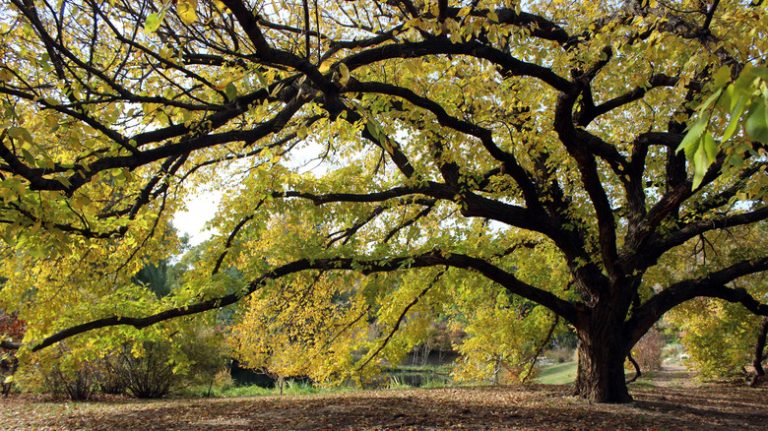The Kousa Dogwood Tree (Cornus kousa) is a beautiful ornamental tree that belongs to the dogwood family. It is native to China, Korea, and Japan and has become popular in many other parts of the world, including the United States. Kousa Dogwood trees are known for their four-season appeal, with stunning blooms, attractive foliage, and colorful fruits.
One of the most impressive features of the Kousa Dogwood tree is its flowers. Unlike other dogwood trees, the Kousa Dogwood blooms after it leafs out. The flowers are small and have a unique shape, with four pointed petals that looks like a star. They appear in late spring and are usually white, although some varieties may have pink or red flowers. The flowers are followed by bright red or orange fruits that resemble raspberries and are loved by birds.
The foliage of the Kousa Dogwood tree is another standout feature. The leaves are medium to dark green and have an attractive texture. The veins are prominent and give the leaves a beautiful effect. In the fall, the leaves turn shades of red, orange, and purple, adding to the tree’s visual appeal.
Kousa Dogwood trees have a rounded, spreading habit with branches that cascade downward. The trunk is typically short and develops a rough, flaky texture as the tree ages. The tree can grow up to 25 feet in height and has a moderate growth rate. It is a great choice for small gardens and can be planted as a specimen tree or used in group plantings.
In terms of care and management, the Kousa Dogwood tree is relatively low-maintenance. It prefers a well-drained soil and is drought-tolerant once established. The tree is also resistant to many common pests and diseases that affect other dogwood trees. However, it is important to note that the Kousa Dogwood tree is not immune to all pests and diseases, and proper monitoring and treatment should be employed if any issues arise.
Overall, the Kousa Dogwood tree is a stunning addition to any landscape. Its beautiful blooms, attractive foliage, and colorful fruits make it a real show-stopper. Whether planted as a specimen tree or used in group plantings, the Kousa Dogwood is sure to attract attention and become a favorite in any garden or county park.
Cornus kousa
Cornus kousa, commonly known as Kousa Dogwood, is a deciduous tree native to Korea and China. It is one of the most popular dogwood species due to its beautiful blooms, smaller size, and resistance to common dogwood fungal diseases.
The Kousa Dogwood can reach a height of 15 to 20 feet and has a trunk that measures approximately 6 to 8 inches in diameter. The tree develops a rounded crown with horizontally spreading branches, creating a lovely four-season display in the landscape.
In spring, the Kousa Dogwood produces clusters of creamy white or pink flowers that resemble upside-down cones. These flowers are followed by edible raspberry-like fruits that cascade from the branches in late summer. The tree’s foliage transitions from glossy green in the summer to vibrant shades of orange and red in the fall.
Cornus kousa has a wide range of environmental requirements and can thrive in full sun to partial shade. It is relatively drought-tolerant once established and can handle a variety of soil types. However, it prefers well-draining soil and should be watered regularly, especially during hot and dry periods.
When it comes to diseases and pests, the Kousa Dogwood is generally less susceptible compared to other dogwood species. However, it can still be affected by some issues like leaf spot, powdery mildew, and dogwood anthracnose. These diseases can be managed through proper tree care, such as regular pruning, maintaining good air circulation, and providing adequate moisture.
In conclusion, Cornus kousa is a beautiful and versatile tree that can enhance any garden or landscape. Its stunning blooms, attractive foliage, and resistance to diseases make it a favorite among gardeners. Whether you’re looking for a tree that provides shade, seasonal interest, or even edible fruits, the Kousa Dogwood is an excellent choice.
Footnotes:
[1] Plant Information Copyright by NC State University All Rights Reserved. Used with Permission.
[2] Image by greensleevesdark. Licensed under CC BY-NC-SA 2.0.
Cornus kousa Kousa Dogwood 1
The Kousa Dogwood (Cornus kousa) is a beautiful tree that is known for its four-season interest. It is native to Korea and parts of China and is commonly planted in landscapes and gardens. The Kousa Dogwood belongs to the Dogwood family (Cornaceae) and is a close relative of the more common American Dogwood (Cornus florida).
One of the standout features of the Kousa Dogwood is its stunning flowers. In late spring, when most other trees have finished flowering, the Kousa Dogwood bursts into bloom. The flowers are small and simple, with four creamy white petals that form a cup-like shape. Each flower is surrounded by four large, pointed bracts that are usually white, but can sometimes have a pink or red tint. The flowers attract bees and other pollinators, adding to the beauty and vitality of the tree.
After the flowers fade, the Kousa Dogwood produces unique fruits. These fruits are about the size of a marble and start off green, turning to a vibrant red or reddish pink in late summer. The fruits are edible, but they are not commonly consumed by humans. However, they are a favorite food source for many birds.
The Kousa Dogwood has attractive foliage throughout the year. The leaves are dark green with a slightly wavy margin and prominent veins. In the fall, the foliage turns a beautiful red, adding to the visual appeal of the tree. The bark of the Kousa Dogwood is smooth and gray on young trees, but as the tree ages, it develops a scaly texture and a mosaic of tan, gray, and brown colors.
Kousa Dogwoods grow to be about 20-30 feet tall and wide, forming a rounded or slightly conical shape. They have a relatively slow growth rate and can live for many years with proper care. These trees prefer full sunlight but can tolerate some shade. They thrive in well-draining soil and have moderate water requirements. While they are not invasive, it is recommended to review their management and control in certain areas where they may become problematic.
Kousa Dogwoods are known for their resilience and adaptability. They are drought-tolerant and can withstand harsh winter conditions. However, in areas with hot summers, the leaves may scorch if the tree is not provided with adequate water. Regular pruning can help maintain a desirable shape and size. Kousa Dogwoods can also be grown as shrubs or used in smaller gardens by selecting cultivars with dwarf or compact growth habits.
In summary, the Kousa Dogwood is a stunning tree that adds beauty and interest to any landscape. With its showy flowers, attractive foliage, and unique fruits, it is a popular choice for gardens and parks. Its resistance to pests and diseases, along with its ability to thrive in various soil conditions, make it a low-maintenance tree that is suitable for both experienced and novice gardeners.
General Information:
The Kousa dogwood tree (Cornus kousa) is known for its beautiful flowering and foliage. It is a native tree to Japan, Korea, and China. The Kousa dogwood tree is often referred to as the “Chinese dogwood” or “Japanese dogwood.” It is loved by gardeners for its lovely white or pink blooms, which cover the tree in late spring to early summer. The tree also has attractive foliage, with dark green leaves that turn gold/yellow in the fall.
The Kousa dogwood tree has a unique branching pattern, with branches that grow in a horizontal, layered fashion. Its trunk is also distinctive, as it has a smooth texture and a gray-brown bark color. The tree typically reaches a height of 15-25 feet, with a spread of 15-30 feet, making it a great choice for landscapes both large and small.
This dogwood tree is known for its resistance to most diseases and pests, including the dogwood anthracnose fungus that affects other dogwood species. Its branching and foliage are also less susceptible to winter damage and scorching. The tree does well in full sun to partial shade, and it prefers well-drained soil.
The Kousa dogwood tree is often used in landscaping for its ornamental features. Its unique branching pattern creates a beautiful silhouette when the tree is leafless in winter. The dense foliage and wide crown provide ample shade during the summer months. The tree’s cup-shaped flowers and attractive fruit also add visual interest to the landscape.
In addition to its aesthetic appeal, the Kousa dogwood tree is also valuable for its environmental benefits. It attracts birds with its fruit, providing a food source for wildlife. The tree is also known to have a positive effect on the environment, filtering pollutants and providing oxygen.
Care for the Kousa dogwood tree is relatively low maintenance. It requires regular watering, especially during dry periods. Pruning can be done to shape the tree and remove any dead or diseased branches. Fertilizing is typically not necessary, as the tree is generally self-sufficient.
In summary, the Kousa dogwood tree is a beautiful and versatile tree that can enhance any landscape. Its stunning flowering, attractive foliage, and unique branching pattern make it a standout choice for homeowners and gardeners alike.
Description
The Kousa dogwood tree (Cornus kousa) is a beautiful ornamental tree known for its stunning flowers and attractive branching structure. It is native to Korea and China and has become a popular choice for landscaping due to its versatility and disease resistance.
One of the most notable features of the Kousa dogwood is its flowers, which bloom in the spring and last for several weeks. The flowers are small and star-shaped, and they typically develop in clusters that cascade along the branches. The showy flowers attract pollinators such as bees and butterflies, adding to the tree’s overall beauty.
In addition to its flowers, the Kousa dogwood also produces fruits. These fruits are small and raspberry-like in appearance, and they range in color from green to red. While they are not typically used for human consumption, they can provide an attractive display in the landscape and may also attract birds.
The Kousa dogwood has a compact and rounded habit, making it suitable for small gardens or as a focal point in larger landscapes. Its branches have an interesting texture, with shiny green leaves that turn red or purple in the fall. The tree’s bark is smooth and gray-brown in color, and it develops a distinctive exfoliating pattern as it gets older.
The Kousa dogwood is generally easy to care for and is resistant to many common diseases and pests. It prefers a well-drained soil and full sunlight, although it can tolerate some shade. Regular watering and fertilization can help the tree thrive, especially during dry periods.
When planting a Kousa dogwood tree, it is important to consider its potential size and growth habit. The tree can reach a height of 15-25 feet and has a spread of 15-20 feet. It should be planted in an area where it will have enough space to grow without interfering with other plants or structures.
In summary, the Kousa dogwood tree is a beautiful and low-maintenance tree that can add an attractive and unique touch to any landscape. Its stunning flowers, attractive branching structure, and resistance to diseases and pests make it a popular choice among gardeners and landscapers.




